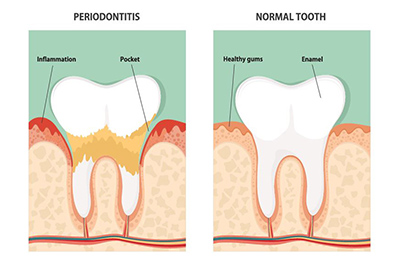Stages of Periodontal Disease
Wed, Oct 9th, 2019
Individuals with healthy dental habits typically have hundreds of different types of bacteria in their mouth (most of them harmless). But failing to properly clean your teeth on a regular basis creates an environment for the bacteria to multiply rapidly, this is how periodontal disease begins.
Periodontal disease is a serious infection of the gums, and as it progresses can severely affect bones and teeth. Luckily, if treated early enough, the damage can be stopped and your mouth can be restored back to normal health. In this blog, we’ll discuss the different stages of periodontal disease and how they affect not only the mouth, but the entire body.
Stage 1 (Gingivitis)
The first stage of periodontal disease starts with inflammation in the gums, aka gingivitis. There are only a couple signs at this stage; bleeding gums and slight discoloration of the teeth. But what makes this disease so dangerous is the fact that many people ignore these seemingly “mild” symptoms. But if the environment in your mouth doesn’t improve, and your habits remain the same, things can get much… much worse.
Stage 2 (Early Periodontal Disease)
Once an individual enters stage 2 periodontal disease, their gums begin to recede and pockets start to form between their gums and teeth. As the pockets grow, they harbor more and more bacteria. In turn, your immune system attempts to battle the infection and your gums start to recede. Basic oral care is no longer a solution for this problem.
Stage 3 (Moderate Periodontal Disease)
Stage 3 is very similar to stage 2, only more severe… the pockets are deeper, allowing for more bacteria to make a home. But at this stage, bone loss in your gums is extreme and bone support is no longer there, creating loose teeth, and worst of all, an inflammatory response throughout your body.
Treatment for this includes scaling and root planing, which is a thorough clean that removes deeply rooted bacteria in your gums. If untreated, the following will get worse; bone loss, tooth loss, gum sensitivity, bleeding and shifting of teeth.
Stage (4 Advanced Periodontal Disease)
In advanced periodontal disease, the tissues that connects your teeth have deteriorated, the gums and bones that reinforce your teeth have been destroyed. Eating is extremely painful, your gums will ooz pus, your breath will be unbearable, and there’s a consistent horrible taste in your mouth. Unfortunately, the odds of losing your teeth are very high at this stage.
Evidence suggests that there is a strong correlation between periodontal disease and numerous other life-threatening conditions. The aforementioned symptoms lead to hardened arteries, making natural blood flow difficult, increasing the risk of a heart attack or stroke.
Preventative Action
Taking necessary steps such as brushing twice daily, flossing everyday and visiting the dentist for a routine cleaning every 6 months will SIGNIFICANTLY increase the odds of avoiding any level of periodontal disease. But if you do start noticing signs such as gum sensitivity or teeth discoloration, don’t hesitate, call Arnold Dentistry immediately to schedule your appointment! (813) 689-1529
Source: HealthLine.com and PasadenaPeriodontics.com






